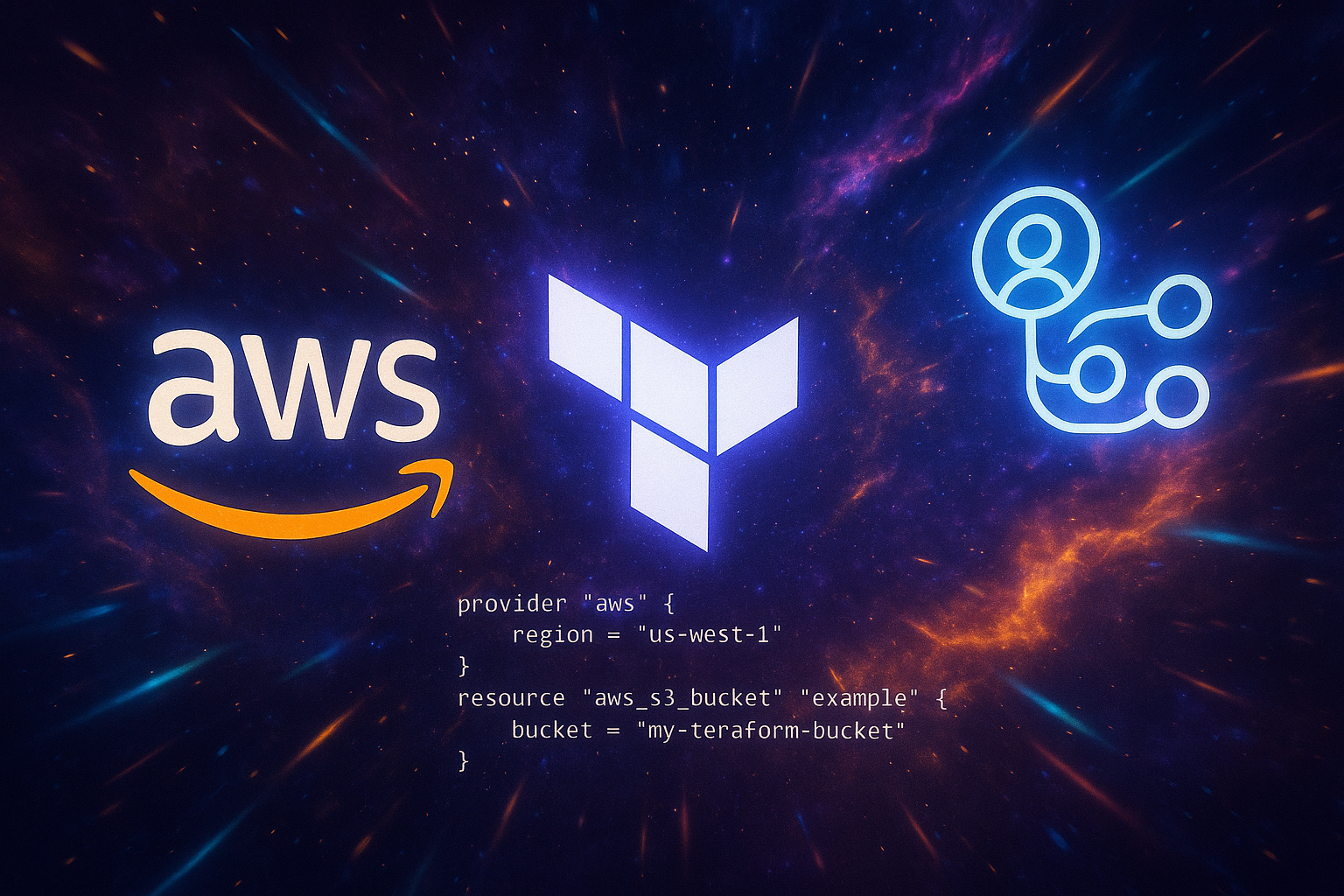Your First DevOps Project
With AWS, Terraform, and GitHub Actions

DevOps is more than just tools — it’s a philosophy aimed at improving collaboration between development and operations. That said, a common question is: “Where do I start?” This guide offers a practical answer.
You won’t find “DevOps in 5 steps” here — but you will find a simple way to start working with tools that can be part of a DevOps culture: AWS as the infrastructure provider, Terraform as the declarative language for provisioning, and GitHub Actions for automation.
Reminder: using these tools alone doesn’t make you a DevOps engineer. But learning them prepares you to contribute to teams that apply real DevOps practices.
What are we building?
A public S3 bucket, provisioned using Terraform and deployed automatically from GitHub.
Prerequisites
- AWS Account. Start with a free-tier account.
- Terraform. Infrastructure as Code.
- GitHub Repository. A repo where you'll store code and workflows.
Code organization
Good structure leads to maintainable code. Define a folder layout that supports growth, new environments, and consistent practices.
dev/
├── us-east-1/
│ └── s3/
│ ├── terraform.tf
│ ├── main.tf
│ └── outputs.tf
stage/
├── us-east-1/
│ └── s3/
prod/
├── us-east-1/
│ └── s3/
modules/
└── s3/
├── main.tf
├── variables.tf
└── outputs.tfWe define three environments: dev, stage, and prod. We also define a reusable Terraform module named s3.
The first folder inside each environment defines the AWS region. The next level defines the specific module used to deploy resources.
What does each file do?
terraform.tf: defines the backend and providers.main.tf: the main logic — instantiates modules and resources.variables.tf: declares inputs (e.g., bucket name).outputs.tf: declares outputs (e.g., the bucket URL).
Your first Terraform code
First, define the backend — this keeps Terraform’s state safely stored. Add this to terraform.tf:
terraform {
backend "s3" {
bucket = "myorg-state-buckets"
key = "s3.tfstate"
region = "us-east-1"
}
}Terraform uses a local backend by default — this works locally, but won’t persist across GitHub Actions runs. That’s why we use a remote backend (like S3 or Terraform Cloud). In this example, we’ll use an S3 bucket.
terraform {
backend "s3" {
...
}
required_providers {
aws = {
source = "hashicorp/aws"
version = "5.99.1"
}
}
}
provider "aws" {
region = "us-east-1"
}Now let’s create the bucket in modules/s3/main.tf:
resource "aws_s3_bucket" "example" {
bucket = var.bucket_name
}
resource "aws_s3_bucket_ownership_controls" "example" {
bucket = aws_s3_bucket.example.id
rule {
object_ownership = "BucketOwnerPreferred"
}
}
resource "aws_s3_bucket_public_access_block" "example" {
bucket = aws_s3_bucket.example.id
block_public_acls = false
block_public_policy = false
ignore_public_acls = false
restrict_public_buckets = false
}
resource "aws_s3_bucket_acl" "example" {
depends_on = [
aws_s3_bucket_ownership_controls.example,
aws_s3_bucket_public_access_block.example,
]
bucket = aws_s3_bucket.example.id
acl = "public-read"
}We use var.bucket_name, which is declared in modules/s3/variables.tf:
variable "bucket_name" {
type = string
description = "Name of the bucket to create"
}Let’s also define an output to get the bucket URL. Add this in modules/s3/outputs.tf:
output "bucket_domain_name" {
value = aws_s3_bucket.example.bucket_domain_name
}Your module is ready! You can now deploy the bucket in dev using dev/s3/main.tf:
module "my_awesome_bucket" {
source = "../../modules/s3"
bucket_name = "dev-awesome-bucket"
}This code deploys a public S3 bucket in the dev environment.
Automating with GitHub Actions
First, authenticate GitHub Actions with AWS.
Go to your repo → Settings → Secrets and variables → Actions, and create these secrets:
AWS_ACCESS_KEY_IDAWS_SECRET_ACCESS_KEY
Then add this workflow at .github/workflows/deploy.yml:
name: Deploy S3 Bucket
on:
push:
jobs:
deploy:
runs-on: ubuntu-latest
steps:
- uses: actions/checkout@v4
- uses: hashicorp/setup-terraform@v3
with:
terraform_version: 1.6.6
- name: Configure AWS Credentials
uses: aws-actions/configure-aws-credentials@v4.1.0
with:
aws-access-key-id: ${{ secrets.AWS_ACCESS_KEY_ID }}
aws-secret-access-key: ${{ secrets.AWS_SECRET_ACCESS_KEY }}
aws-region: us-east-1
- name: Terraform Init
run: terraform init
- name: Terraform Apply
run: terraform apply -auto-approveWhat’s next?
That was your first step. Now you can:
- Configure DNS to point to your bucket (via Route 53)
- Create a CloudFront distribution to enable caching and better latency
- Build your own website and host it on S3
Learning DevOps isn’t about memorizing commands — it’s about understanding how to connect tools to build reliable pipelines. And today, you took a great first step!